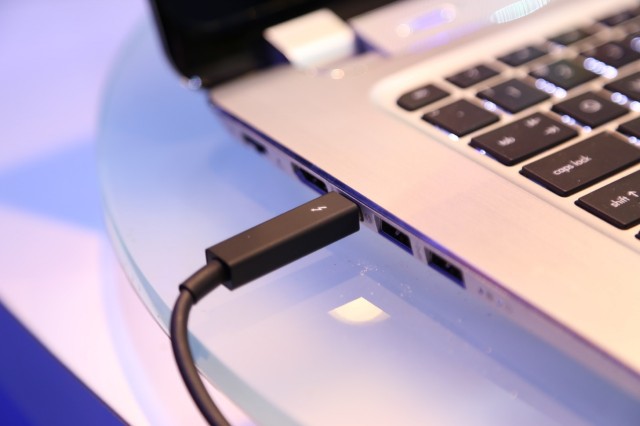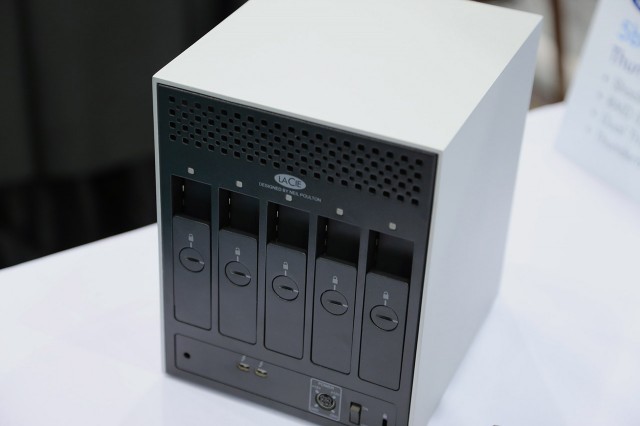
Intel launched Thunderbolt in February 2011, choosing Apple as its first OEM partner. Almost two years later, the high-speed interconnect is still an expensive, niche connectivity option, despite the fact that it has spread to Windows PCs and numerous vendors have announced Thunderbolt-compatible products. As the standard begins to mature, will the technology begin to break out of its niche?
It's hard to say with absolute certainty, but it appears that the groundwork laid in 2012 may slowly start to pay off in 2013.
Cables, great and small
Unsurprisingly, as the first computer vendor to widely adopt Thunderbolt, Apple was also the first vendor out of the gate with Thunderbolt cables. However, the cables were pricey at $50 each. Some observers were practically apoplectic over the price, while others compared the price to that of other high-speed, bi-directional interconnects which often require much more exotic and expensive hardware.
Other cables eventually hit the market, but prices weren't better than what Apple offered. Semiconductor manufacturer Intersil promised that its next-generation Thunderbolt transceiver chips—a necessary component of Thunderbolt cables—would bring prices down in 2013. The improved transceivers required fewer support chips, could use lower-cost, thinner conductors, and could reduce manufacturing costs by building signal testing right into the chips themselves.
It appears that Intersil's design is beginning to pay off. At Intel's booth at CES this year, we saw new thinner, more flexible Thunderbolt cables manufactured by Japanese OEM Sumitomo. And last Friday, Apple quietly dropped the price of its 2m Thunderbolt cable from $50 to $40. It's still not down to the price of commodity USB cables, for example, but prices do appear to be going down.
Another cabling option that was promised at Thunderbolt's launch was optical cables that could run as long as 100 meters. The original version of Thunderbolt, codenamed LightPeak, was in fact originally designed as an optical interconnect. The version that Intel shipped used a copper cable that used a plug based on Apple's mini DisplayPort design, which had been adopted by VESA as an open standard. Copper cables allowed a lower-cost design while adding power transmission for bus-powered devices. But moving the transceiver into the cable also allowed the flexibility to optionally use optical cables for much longer connections when required.
Corning announced one of the first optical cable options just ahead at CES, and Intel also had some samples at its booth. Pricing has not been discussed, but optical cables tend to cost more than copper. However, if a computer needs to be located in a closet, an optical cable could be used to connect displays, storage, or other devices in the other room or even down the hall.
More devices are coming
Dozens of Thunderbolt devices, including portable and desktop hard drives, RAIDs, multiport "docks," portable video capture devices, and more were unveiled at CES, as well as NAB and Computex, in 2012. Thunderbolt was the hot new technology that was going to revolutionize high-speed data access for consumers, and the excitement of device makers was palpable.
The story was much more sedate at CES this year. Few new products were announced. LaCie showed off its large 5big five-slot RAID box in Thunderbolt form, set to ship early in the year. Seagate, Western Digital, G Technology, and others had nothing new or radical to discuss.

But some vendors were showing off products that had long been announced but have yet to ship. For instance, peripheral maker Belkin had its Thunderbolt Express Dock (first announced as far back as September 2011) in what it called a final functional form on the CES show floor last week. Belkin representatives promised the Express Dock would—for really real this time—ship in the first quarter of 2013. The launch price, which had gone up to $400 over the course of development, is now back down to $300.
Apple may also be preparing a second-generation Thunderbolt Display. Resellers have noted that inventory of the current Thunderbolt Display has begun to run dry, typically the first sign that Apple is planning a product refresh. Since the current Thunderbolt Display uses technology from previous Cinema Displays and iMacs, it seems likely a newer version would include the improved LCD panels, thinner design, and USB 3.0 support of the newest iMac models.
Still, Apple is the only vendor shipping a Thunderbolt-equipped display. We saw a Thunderbolt display from AOC at CES 2012, but we didn't see any mention of the technology from display vendors this year. Nor have we heard about AOC shipping a version of the prototype we saw last year.
What's the hold up?
More devices from more vendors would create more competition and help drive prices down. But what's holding back the flood of Thunderbolt devices, especially those from other vendors, from coming to market at a faster pace?
Part of the delay was the high cost of the first generation of Thunderbolt controller chips. Intel launched a wider range of second-generation controllers along with Ivy Bridge in 2012, and more OEMs have begun looking at ways to integrate those lower-cost chips into newer products.
But cost isn't the only consideration. Another concern has been support from OS vendors. For instance, a Belkin representative told Ars that there was a bug in OS X that prevented a USB keyboard connected to a Thunderbolt bridge from waking a Mac from sleep. That bug has since been addressed in 10.8.2, however. Intel is also continually improving Thunderbolt drivers for Windows, according to a representative we spoke to at CES.
The one final factor—one that has likely had the most impact on Thunderbolt rolling out to market—is Intel's licensing and certification process. Several vendors we have spoken to over the past year have claimed that Intel was holding up the process, cherry picking which vendors it worked with.
Though Intel had effectively denied this characterization in the past, the company explained the situation a bit differently when we spoke at CES last week. Jason Ziller, director of Thunderbolt Marketing & Planning at Intel, told Ars that Intel has "worked closely" with vendors it felt could "offer the best products" and could meet its stringent "certification requirements." The subtext seemed to be that Intel had limited resources to support and certify new products, and so it gave priority to devices that were perhaps more novel than those proposed by other makers.
Ziller suggested that licensing to a wider variety of vendors would begin to open up this year, and we could see more products being announced soon.
Bring it on
Apple isn't giving up on Thunderbolt anytime soon. All of its computers come with at least one Thunderbolt port—save the Mac Pro, which Apple CEO Tim Cook has all but promised would be upgraded in 2013. The latest Retina MacBook Pros include two Thunderbolt ports. And it appears that its Thunderbolt Display is due for a refresh sometime soon.
Though Thunderbolt hasn't exactly taken the Windows PC world by storm, several motherboard makers now offer options for built-in or add-on Thunderbolt support. And notebook makers are adding Thunderbolt as well—Intel's booth this year featured a classy-looking HP Envy Spectre Ultrabook for demonstration purposes.
Meanwhile, Thunderbolt is largely serving two main purposes right now: dock-like port expanders for thin Ultrabooks, and high-performance storage which might otherwise be connected by FireWire or even FibreChannel. With optical cabling coming soon, it will also be one of the best solutions for connecting computers to peripherals that are up to 100m away.
Even within those limited applications, however, Thunderbolt offers a price-to-performance advantage over competing technologies. And as Thunderbolt expands throughout the next year, that advantage should increase.
reader comments
306